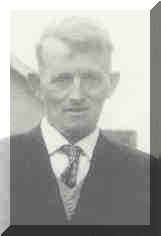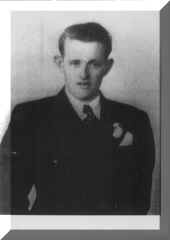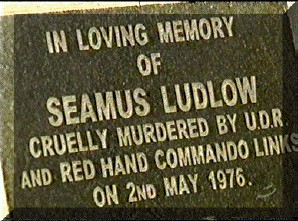The Murder of Seamus Ludlow in County Louth, May 1976. Towards a public inquiry?



The Murder of Seamus Ludlow in County Louth, May 1976. Towards a public inquiry?
|
|
Introduction to the murder of Seamus Ludlow and the official cover-up. Michael Cunningham investigation - 1978 The recent Campaign for Truth and Justice. Irish Victims Commission Report. Ludlow family's questions for the RUC (now the PSNI). Jim J. Kane's letter to the N I Human Rights Commission. Jim J. Kane's letter to the RUC Ludlow Family Letter to Bertie Ahern Other Ludlow Family Sites. |
The Argus, 26 February 1999, On the night of May 1st/2nd 1976, Seamus Ludlow, an unmarried forestry worker from Mountpleasant in Dundalk was found murdered in a ditch near his home. No one was ever brought to justice for his killing, no motive established but his family who held a public meeting in Dundalk last Thursday night are demanding a full investigation. Francis Carroll reports: Claim the police know who did killing A large crowd gathered at the Town Hall, Dundalk, on Thursday night for a public meeting organised by the family of the late Seamus Ludlow who was murdered on 1st/2nd May 1976 by a loyalist gang near his home. Friends and neighbours, as well as concerned members of the wider community and public representatives were urged to lend their support to the campaign for a full independent and public enquiry by both the Irish and British Governments into the matter which remains unsolved after almost 23 years. However, those present at the Town Hall heard that police authorities north and south of the border are fully aware of who was responsible for the killing, yet no action has been taken against them - a file on the case lies in the DPP's office in Northern Ireland. Local Gardai were heavily criticised for their handling of the affair and their behaviour towards the bereaved family described as "terrible", while the smear campaign against the dead man was denounced. It is believed a campaign was orchestrated to protect the man who shot Seamus Ludlow, in other words the State covered up a murder carried out in the Republic of Ireland by loyalist terrorists. It was also claimed that the same murderer, who was possibly a British agent or informer, went on to kill again a number of times afterwards. The public meeting was chaired by Msgr Raymond Murray, who included the murder of Seamus Ludlow in his book 'The SAS in Ireland', and he was joined at the top table by Jane Winter of the London-based British Irish Rights Watch whose report was before the meeting, and by a number of the deceased's relatives: brother Kevin Ludlow; nephews Jimmy Sharkey, Michael Donegan and Brendan Larkin and niece, Imelda Ludlow. Msgr Murray pointed out that half the murders throughout the thirty years of conflict remained unsolved and many of them were covered up. A murder was bad enough, but it was more serious still when the State was implicated. He continued that the attempt to blacken the character of Seamus Ludlow was in many ways the worst crime of all. Msgr Murray told the gathering that if they wanted justice, it meant a crusade to allow justice come to the fore. "It takes a campaign," He referred to the case of murdered solicitor, Pat Finucane and given recent developments had no doubt it would break in due course.
Seamus Ludlow The Ludlow family have many questions they want answered, but at the end of the day want nothing more than the truth to come out of an independent public enquiry. They know there is no chance of the perpetrators being prosecuted and even if they were they would be persuaded to plead guilty, so as nothing would come out in the trial. Even at that, Michael Donegan believes the men would only get a slap on the wrist and do little jail time, if any at all. "An enquiry has to be seen to be public, above board, independent and properly resourced. We will find the truth, we're not going to be fobbed off," said Mr Donegan. He added the bottom line was that a British loyalist murder in the south had been covered up. Among the questions the family want answered are: 1. Why did the initial Garda investigation into the murder suddenly stop after three weeks? 2. Why did the British Army take such an interest in the conduct of the Garda investigations? 3. Why were the family excluded from the inquest on 19th August 1976 and who was responsible for this exclusion? 4. Were any ballistics or forensic reports presented at the inquest? 5. Exactly what information did the Gardai hold about the murder and for how long was this information held? 6. Why was the information passed to Detective Chief Superintendent Courtney by the RUC in 1979 never acted upon? 7. Who was primarily responsible for the decision not to act upon this information? 8. Will the Gardai publicly apologise for and retract the allegations made that Seamus Ludlow was an IRA informer? 9. What are the results of the current Garda enquiry into their original investigation of the murder and what subsequent action will be taken? 10. Why did the RUC Special Branch take no action following Paul Hosking's statement given in 1987 regarding the identity of the killers? 11. Were the RUC trying to protect an informer amongst the murderers of Seamus Ludlow? 12. Will charges be brought against the suspects arrested in February 1998 by the Northern Ireland Director of Public Prosecutions and if so when? 13 Will the Gardai and RUC be held accountable for their actions?
Family feel that Irish authorities colluded in a cover-up to protect the guilty One of the most disturbing aspects of the Seamus Ludlow case is that of a cover-up, or protection of one, possibly more, of the men who were in the car that night. Jimmy Sharkey believes Gardai were told not to act on the matter by a higher authority, be it the Department of Justice, Department of Foreign Affairs, or the Government of the time. "Who were they protecting? I have no doubt they were protecting the man who murdered Seamus Ludlow." He also asks was the man who pulled the trigger a British agent or an informer. Mr Sharkey is of the opinion that the loyalist gang didn't travel south to kill his uncle. "They were here on a mission that perhaps didn't materialise or went wrong. We have to know the truth and are entitled to it after 23 years." He revealed that six weeks after Seamus Ludlow was killed, the same gunman and UDR captain killed a man in Comber. The UDR man was arrested and subsequently jailed, but his accomplice was let go free "to kill again and again." He says there must be an independent public enquiry and the family were going to keep fighting for one. The evidence was so strong that they thought charges would be pressed, but they weren't. It was said the case was too old. Another part of the cover-up was the inquest held in Dundalk on the 19th August 1976. Kevin Ludlow was informed it was taking place 45 minutes beforehand, while another family attending an inquest the same day were given one week's notice, Mr Sharkey continued. "We want to know why the murder was covered-up and who were the people being protected."
Interview implicated UDR captain in death The Ludlow family's campaign to learn the truth about the murder gathered pace when they were contacted by investigative journalist, Joe Tiernan who told them he knew who killed Seamus and gave them a list of names. A press conference was held on 2nd May 1976, the 20th Anniversary of the death, and the information available sent to the Gardai who subsequently met with the family on about six occasions over a period of 8 months. Jimmy Sharkey said he was told by a member of the Gardai that they were aware of the names from as far back as 1979, having been furnished with four suspects' names by the RUC which were put in a classified file. On 17th February, 1998 four men were arrested by the RUC and taken to Castlereagh Holding Centre, the gunman having been arrested in Staffordshire and taken over. They were all released without charge. On 8th March 1998 the "Sunday Tribune" published an interview with one of the four men who were in the car, Paul Hosking. He told in graphic detail what occurred on the night. According to Hosking, from Newtownards, on 1st May 1976 he was drinking in his local bar in Comber with a few friends. By chance, he met up with three other men whom he knew socially. These three men were known to be members of the Red Hand Commando, two of whom were also members of the Ulster Defence Regiment (UDR). One was a captain in the UDR, the second was also an officer. The third man was from Bangor. The pub was deserted, so Paul Hosking spent the afternoon with them. He noticed that the UDR men were armed. Hosking, together with the three men moved on to another pub. They drove the second UDR man's car, a yellow two-door Datsun. Paul Hosking was in the rear passenger seat with the UDR captain and "Mambo" was in the front passenger seat. These seating arrangements did not change over the period in question. This pub was also quiet so the UDR captain made a suggestion. According to Hosking, he "mentioned there were supposed to be IRA checks along the border. It was information obviously from the UDR that they were doing something on the border. He said do you fancy going down to spy on them? I said, great, it was like an adventure." They were waved through a permanent British Army checkpoint after the driver showed his UDR pass. They spent about an hour in a pub in Omeath where Paul Hosking watched a football match on his own away from the others. It was after closing time when they left the pub. Hosking said by then he was drunk as he had consumed around 13 or 14 pints that day. They drove south towards Dundalk where they came across a man thumbing a lift. The car stopped and they let the man into the back. The car drove out the Newry Road to Thistle Cross where Seamus Ludlow said he lived. They then turned right and down the Bog Road for about a mile before coming to a lane on the left which they reversed into. According to Hosking: "one of the men got out and pulled the seat back and I got out. I went over to the hedge in front of the car. I was standing having a pee and the next thing I heard was banging. I swung round there was this guy sort of half in the car and he was shooting in the car. "All I remember then is your man pulling him out and (another man) was pushing him out. The guy fell on the floor so they got out and picked him up and threw him on to a hedge I think it was". Jimmy Sharkey added at the meeting that his uncle was shot in the kidney. He was then shot through his left hand and into his lung after he tried to protect himself. The fatal shot was to the heart. Having gone to live in Scotland in 1978, Paul Hosking returned to live in Comber in 1986 and early the following year met an RUC Special Branch officer "who seemed to know all the story". The officer told Paul Hosking that he knew he had been there, but hadn't been involved. He was asked to provide his own account of events after which, the officer said "forget it, it's political." The next thing he heard about the murder was not until his arrest in February 1998 along with three other men.
I Homepage I I Top I I Press Coverage I |